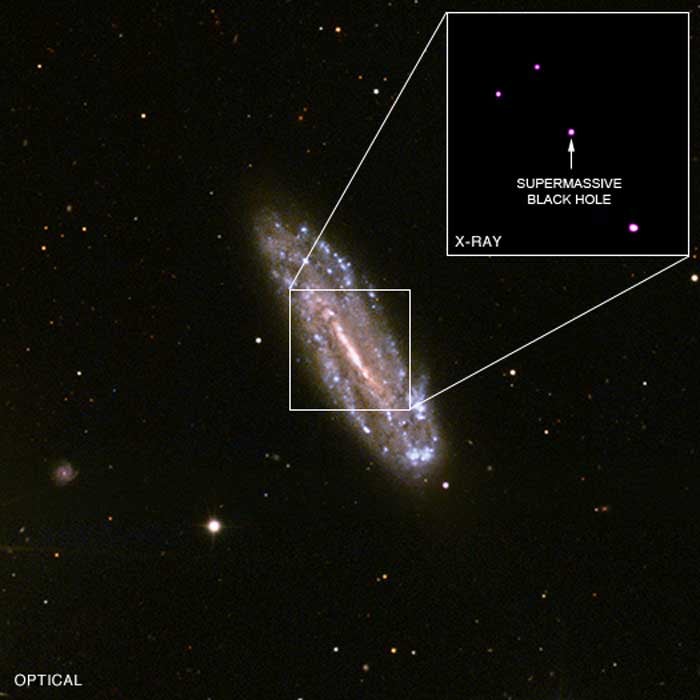The black hole is located in the middle of the spiral galaxy NGC 4178, shown in this image from the Sloan Digital Sky Survey. The inset shows an X-ray source at the position of the black hole, in the center of a Chandra image. An analysis of the Chandra data, along with infrared data from NASA’s Spitzer Space Telescope and radio data from the National Science Foundation’s Very Large Array, suggests that the black hole is near the extreme low-mass end of the supermassive black hole range.
The properties of the X-ray source, including its brightness and spectrum — the amount of X-rays at different wavelengths — and its brightness at infrared wavelengths, suggest that a black hole in the center of NGC 4178 is rapidly pulling in material from its surroundings. The same data also suggest that light generated by this infalling material is heavily absorbed by gas and dust surrounding the black hole.
Astronomers used a known relationship between the mass of a black hole and the amount of X-rays and radio waves it generates to estimate the mass of the black hole. This method gives a black hole mass estimate of less than about 200,000 times that of the Sun. This agrees with mass estimates from several other methods employed by the authors and is lower than the typical values for supermassive black holes of millions to billions of times the mass of the Sun.
NGC 4178 is a spiral galaxy located about 55 million light-years from Earth. It does not contain a bright central concentration, or bulge, of stars in its center. Besides NGC 4178, four other galaxies without bulges are currently thought to contain supermassive black holes. Of these four black holes, two have masses that may be close to that of the black hole in NGC 4178. XMM-Newton observations of an X-ray source discovered by Chandra in the center of the galaxy NGC 4561 indicate that the mass of this black hole is greater than 20,000 times the mass of the Sun, but the mass could be substantially higher if the black hole is pulling in material slowly, causing it to generate less X-ray emission.
The mass of the black hole in galaxy NGC 4395 is estimated to be about 360,000 times the mass of the Sun.
Previously, astronomers have found that observations of a large number of galaxies are consistent with a close correlation between the mass of a supermassive black hole and the mass of the bulge of its host galaxy. Theoretical models developed to explain these results invoke mergers of galaxies and predict that galaxies without bulges are unlikely to host supermassive black holes. The results found that NGC 4178 and the four other galaxies mentioned run counter to these predictions and may suggest that more than one mechanism is at work in forming supermassive black holes.
Three other X-ray sources were found in the Chandra image. If they are located in NGC 4178, they are likely to be binary systems containing a black hole or neutron star. The brightest of the three sources may be an intermediate-mass black hole with a mass that is about 6,000 times that of the Sun.










